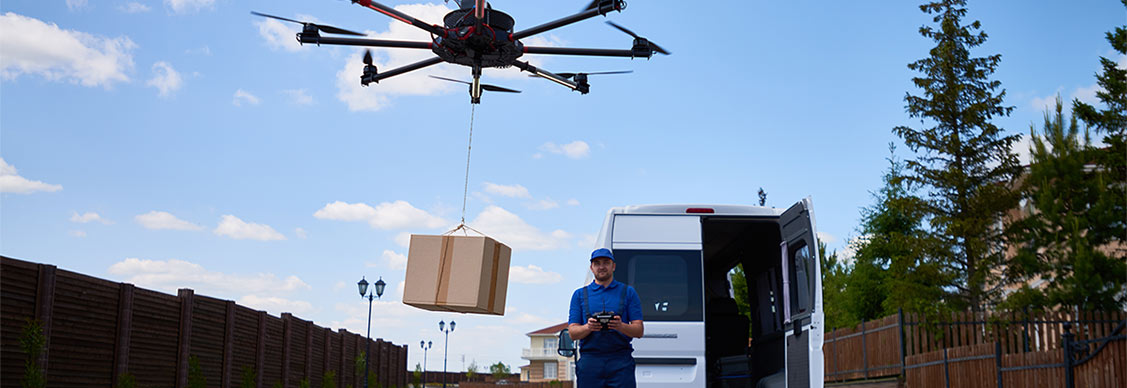The drones are coming, but can they deliver?
More logistics firms and retailers are turning to drones for last mile deliveries
The sight of drones dropping parcels in back gardens or balconies is closer than ever as more aviation authorities give trial schemes the green light amid growing interest from retail and logistics players.
Spanish innovator GesDron recently launched a pilot for Europe’s first home delivery drone for food orders in Madrid while Ireland now has drone service Manna delivering groceries, takeaways and medicines in two towns, with plans for rapid expansion in the UK and U.S.
Earlier this year, the UK’s Civil Aviation Authority approved plans for Sees.ai to begin test flights using remote piloting – a significant step forward from previous trials in which drones had to remain in view.
Meanwhile, 16 public and privately owned organisations in Sweden, Finland, Norway and Denmark just backed an initiative to probe the efficient use of airspace for drones.
Europe’s efforts mirror those in the U.S., where the likes of logistics firm UPS and Amazon have been piloting schemes following approval from the U.S. Federal Aviation Administration.
A fast-changing space
While still some way off mass adoption, drones have huge potential to transform the logistics sector as technology advances at speed and consumer demand for convenience grows, says Ashley Smart, EMEA logistics development director at JLL.
Indeed, research firm MarketsAndMarkets predicts the glocal market for drone delivery will grow from $528 million in 2020 to $39 billion by 2030.
“There has, and continues to be, progress on the research and development side and those technological advances have stimulated governments to come up with new rules and regulations, which of course differ from country to country,” he says. “But it’s only recently that we are starting to see some steps made by third party logistics providers (3PLs).”
The UK’s Royal Mail is now trialing drone deliveries for the first time to deliver letters and Covid-19 testing kits to the Isles of Scilly.
Over in the U.S., retailer Kroger is following in the footsteps of Walmart by running its own pilot drone schemes to deliver groceries in as little as 15 minutes.
Drone technology itself is also evolving with a new German model from Wingcopter capable of delivering three parcels in one go.
“All things point towards greater use but there are a few challenges to overcome for it go further,” says Smart.
From concerns over safety and privacy in low lying airspace to energy efficiency, drone delivery is not quite ready for large-scale commercial take-off just yet.
But efforts such as the Nordic Drone Initiative – where several countries with common regulatory areas have come together – could speed things up, Smart believes.
Looking for more insights? Never miss an update.
The latest news, insights and opportunities from global commercial real estate markets straight to your inbox.
Homes for drones
Back on the ground, warehouses will also need to adapt to manage a steady flow of drone deliveries.
“How those 3PLs factor in drones will play a big part in their success – but it’s also about futureproofing warehouses, which have historically gone through little change in terms of their configuration over the years,” says Smart. “Buildings will need to accommodate drones in just a few years’ time if technical and regulatory progress continues at its current pace.”
Incorporating charging points, roof hatches or sky lights, or more space outside for drone landing pads, may not only mean altering warehouse design but rethinking picking and packing operations, as well as shipping methods.
“3PLs more used to dispatching multiple items will be switching to single items being sent out individually – that alone is a big change to overcome given traditional delivery methods,” Smart says.
Royal Mail’s delivery process, for example, involves an un-crewed aerial vehicle carrying up to 100kg of mail to an airport. From there, a smaller drone takes deliveries to dedicated points.
“And of course, urban areas will also need to rethink their current airspace regulations,” says Smart, pointing to the city of Madrid’s stipulation that currently restrict drones from built-up areas.
But drones are clocking up the miles in more remote locations; France’s La Poste has a small-scale drone delivery service up and running with drones transporting packages up to the village of Mont-Saint-Martin in the Alps.
The cost of scaling up may raise questions over financial feasibility – and damage to and a loss of drones over time could alone prove to be prohibitive. But as Smart points out, drones were always more likely to play a supporting rather than main role in the delivery process.
“They’re on their way now and the level of discussion among supply chain players has risen,” says Smart. “With more trials underway, the coming months will give us more clarity as to how big a delivery role drones can actually play in future logistics networks.”
